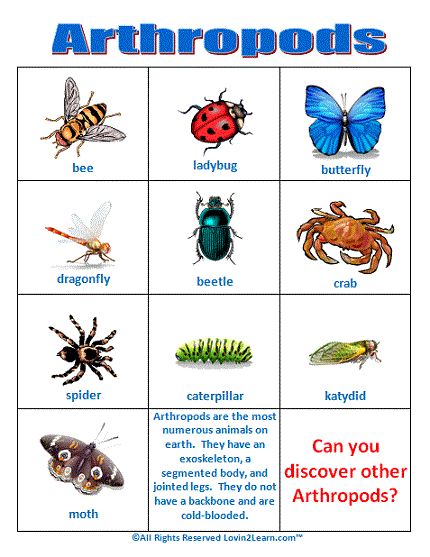ARTHROPODS

The Largest Animal Group
Arthropods are animals with segmented bodies and six or more jointed legs. They are the largest animal group on Earth. In fact, more than three out of four of all animals are arthropods. They are found everywhere – on land, in trees, in freshwater and saltwater, and even underground. Arthropods are generally small. Most are less than 1 cm long. Some arthropods, however, are quite large. The giant king crab, for example, measures over 3.2 m from the tip of one outstretched leg to another. Some of the most familiar arthropods are butterflies, beetles, flies, ants, bees, spiders, scorpions, shrimp, and crabs.
Six Legs, Eight Legs, Ten Legs, or More!
There are many strange and beautiful arthropods. Most belong to one of three major groups: insects, crustaceans, or arachnids.
Insects have six legs. They are the only arthropods capable of powered flight. Dragonflies are the most spectacular. Some can fly at speeds over 64 kph! Every year, scientists discover and describe thousands of new arthropod species. Most are new insects.
Arachnids have eight legs. Spiders are, perhaps, the best-known arachnid. Most arachnids live on land, although a few live in freshwater. Scorpions, mites, and ticks are also arachnids.
Crustaceans have ten or more legs. Most are aquatic, which means they live in water. Most aquatic crustaceans – crabs, lobsters, and shrimp – live in the sea. A few crustaceans live in freshwater streams and lakes. Some, like woodlice, live on land. Both the largest and smallest arthropods in the world are crustaceans.
Arthropods Make Good Eating
Arthropods are critical to the food chain. They are the major source of food for most other animals and even a few plants. Birds, reptiles, fish, and other arthropods eat them. Even people eat arthropods. In the oceans, arthropods such as krill, copepods, and other crustaceans form the foundation of the food chain on which most fish and sea mammals survive. Even the largest animal in the world, the blue whale (which weighs 108 metric tons), feeds on plankton. Plankton is a floating soup of marine arthropods, plants, and other tiny animals.If you’ve eaten shrimp, crab, or lobster, then you’ve made a meal of an arthropod.
Arthropod Anatomy
All arthropods have jointed legs and a head and segmented body parts called the thorax and abdomen. An arthropod’s body is covered by a shell or a hard outer skin called anexoskeleton. It is made of a material called chitin. The exoskeleton has a special top layer, the cuticle, which is thick and tough. In crustaceans, the exoskeleton is sometimes called the carapace and hides the segmented body parts.
Arthropods are a very diverse group, but they share some basic characteristics. Click below to discover their similar features.
It’s an Arthropod’s Life
Because there are so many different types of arthropods, there are also many different ways in which they develop and grow. Most begin as eggs, hatch into larvae, and then metamorphose into adults.
Outgrowing Their Skins
Having a hard exoskeleton provides good protection. But it can be a disadvantage when an arthropod is growing. Arthropods must shed their exoskeleton and grow a new, larger one. As an arthropod grows, its exoskeleton splits along the back of the thorax. The arthropod can then crawl out of its old exoskeleton. It can take several minutes or up to a few hours for the new exoskeleton to harden. During this time, the arthropod is without its “armor” and can be attacked very easily.
Making Major Changes
Arachnids – spiders, scorpions, and ticks – hatch from eggs and look like small versions of their adult parents. But many arthropods change dramatically between the time they hatch and the time they reach adulthood. For example, flightless caterpillars (the larval stage of moths and butterflies) turn into winged adults. Ladybugs look like miniature dragons until they metamorphose. Strange little creatures called zoea look like they have come from outer space. They swim about the ocean before settling to the bottom and becoming crabs.
Arthropods and People
Many people do not understand the vital role arthropods play in keeping the world alive and healthy. Life on Earth would end very quickly without arthropods. Arthropods are great recyclers and decomposers and they are a super food source. They also help pollinate the plants that provide food and keep the air and water clean.
Arthropods to Avoid
Arthropods such as flies, lice, fleas, ticks, and mosquitoes can make your life uncomfortable if they bite you. Some insects, arachnids, and millipedes produce poisons that can make people sick or even kill them. Arthropods are also indirectly responsible for many people dying. Certain kinds of mosquitoes are very dangerous. They may carry diseases like malaria and dengue fever. Malaria passed on to people by mosquitoes kills over 1 million people each year- that’s more than any other disease.
0 comentarios